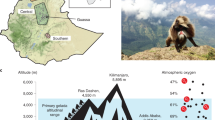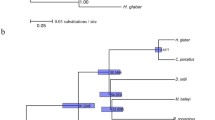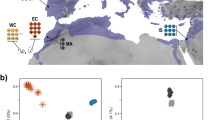Abstract
Chinese snub-nosed monkeys (genus Rhinopithecus, subfamily Colobinae), including R. bieti, R. brelichi and R. roxellana, are well-known as the non-human primates with the highest known altitudinal distribution. They represent an interesting model organism of adaptation to the extreme environmental stresses. However, no study at the molecular level has yet been reported for the high-altitude adaptation in Chinese snub-nosed monkeys. Leptin, as an adipocyte-derived hormone, is believed to play an important role in energy homeostasis in adaptation to high altitude environments. In the present study, we sequenced and compared leptin sequences of the Chinese snub-nosed monkeys (R. bieti and R. roxellana) with their lowland close relative R. avunculus and other Colobines. Unexpectedly, no amino acid changes were observed in the 7 Colobinae species examined, including the 2 Chinese snub-nosed monkeys, indicating no difference in the evolutionary pattern of the Leptin gene between high-altitude monkeys and their lowland counterparts. In contrast to a previous finding of adaptive evolution of Leptin gene in plateau pikas, our study suggests that this gene may not have an important role in high-altitude adaptation of Chinese snub-nosed monkeys. Other nuclear genes associated with energy metabolism, or mitochondrial genes, are most likely to be involved the molecular mechanism underlying adaptation of these monkeys to cold and hypoxia associated with the highland environment.
Similar content being viewed by others
References
Huntley B, Webb T. Migration: Species’ response to climatic variations caused by changes in the earth’s orbit. J Biogeogr, 1989, 16: 5–19
Szalay F S, Delson E. Evolutionary History of the Primates. New York: Academic Press, 1979
Luo Y, Gao W, Gao Y, et al. Mitochondrial genome analysis of Ochotona curzoniae and implication of cytochrome c oxidase in hypoxic adaptation. Mitochondrion, 2008, 8: 352–357
Xu S Q, Luosang J, Hua S, et al. High altitude adaptation and phylogenetic analysis of Tibetan horse based on the mitochondrial genome. J Genet Genomics, 2007, 34: 720–729
Saraste M. Oxidative phosphorylation at the fin de siècle. Science, 1999, 283: 1488–1493
Lopez-Barneo J, Pardal R, Ortega-Saenz P. Cellular mechanism of oxygen sensing. Annu Rev Physiol, 2001, 63: 259–287
Da Fonseca R R, Johnson W E, O’Brien S J, et al. The adaptive evolution of the mammalian mitochondrial genome. BMC Genomics, 2008, 9: 119
Gu M L, Wang Y J, Shi J, et al. Comparison on mitochondrial ATP6 ATP8 and Cytb genes between Chinese Tibetans in three different zones: Detecting the signature of natural selection on mitochondrial genome. Hereditas, 2009, 31: 147–152
Gering E J, Opazo J C, Storz J F. Molecular evolution of cytochrome b in high- and low-altitude deer mice genus Peromyscus. Heredity, 2008, 102: 226–235
Trayhurn P, Duncan J S, Rayner D V. Acute cold-induced suppression of ob obese gene expression in white adipose tissue of mice: Mediation by the sympathetic nervous system. Biochem J, 1996, 311: 729–733
Li X S, Wang D H. Regulation of body weight and thermogenesis in seasonally acclimatized Brandt’s voles (Microtus brandti). Horm Behav, 2005, 48: 321–328
Peino R, Pineiro V, Gualillo Q, et al. Cold exposure inhibits leptin secretion in vitro by a direct non-specific action on adipose tissue. Eur J Endocrinol, 2000, 142: 95–199
Grusfeld A, Andre J, Mouzon S H, et al. Hypoxiainducible factor 1 transactivates the human Leptin gene promoter. J Biol Chem, 2002, 277: 42953–42957
Yang J, Wang Z L, Zhao X Q, et al. Natural selection and adaptive evolution of leptin in the Ochotona family driven by the cold environmental stress. PLoS One, 2005, 3: e1472
Kirkpatrick R C, Long Y C, Zhong T, et al. Social organization and range use in the Yunnan Snub-nosed monkey Rhinopithecus bieti. Int J Primatol, 1998, 19: 13–51
Li M, Liang B, Tamate H B, et al. Molecular phylogeny of Sichuan snub-nosed monkey Rhinopithecus roxellae with cytochrome b sequences. Primates, 2001, 42: 153–160
Li M, Wei F W, Huang C M, et al. Phylogeny of snub-nosed monkeys inferred from mitochondrial DNA Cytochrome B and 12S rRNA sequences. Int J Primatol 2004, 25: 861–873
Li M, Liu Z, Gou J, et al. Phylogeography and population structure of the golden monkeys Rhinopithecus roxellana: Inferred from mitochondrial DNA sequences. Am J Primatol, 2007, 69: 1195–1209
Davies A G, Oates J F. Colobine Monkeys: Their Ecology Behaviour and Evolution. Cambridge: Cambridge University Press, 1994
Altschul S F, Gish W, Miller W, et al. Basic local alignment search tool. J Mol Biol, 1990, 215: 403–410
Thompson J D, Higgins D G, Gibson T J. CLUSTAL W: Improving the sensitivity of progressive multiple sequence alignment through sequence weighting position specific gap penalties and weight matrix choice. Nucleic Acids Res, 1994, 22: 4673–4680
Tamura K, Dudley J, Nei M, et al. MEGA4: Molecular evolutionary genetics analysis MEGA Software version 40. Mol Biol Evol, 2007, 24: 1596–1599
Weber R E. High-altitude adaptations in vertebrate hemoglobins. Resp Physiol Neurobi, 2007, 158: 132–142
Moore L G, Zamudio S, Zhuang J. Analysis of the myoglobin gene in tibetan living at high altitude. High Alt Med Biol, 2002, 3: 39–45
Batney M D, Bahadori L, Gold L I. Vascular remodeling in primary pulmonary hypertension potential role for transforming growth factor-β. Am J Pathol, 1994, 144: 285–295
Issac D D, Andrew D J. Tubulogenesis in Drosophila: A requirement for the trachealess gene product. Gene Dev, 1996, 10: 103–117
Xu S Q, Yang Y Z, Zhou J, et al. A mitochondrial genome sequence of the Tibetan antelope (Pantholops hodgsonii). Genom Proteom Bioinformat, 2005, 3: 5–17
Rocco F D, Parisi G, Zambelli A, et al. Rapid evolution of cytochrome c oxidase subunit II in camelids Tylopoda Camelidae. J Bioenerg Biomembr, 2006, 38: 293–298
Ning T, Xiao H, Li J, et al. Adaptive evolution of the mitochondrial ND6 gene in the domestic horse. Genet Mol Res, 2010, 9: 144–150
Hassanin A R, Couloux A C. Evolution of the mitochondrial genome in mammals living at high altitude: New insight from a study of the Tribe Caprini (Bovidae Antilopinae). J Mol Evol, 2009, 68: 293–310
Author information
Authors and Affiliations
Corresponding authors
About this article
Cite this article
Wang, X., Jin, W., Yu, L. et al. Molecular evolution of stress-response gene Leptin in high-altitude Chinese snub-nosed monkeys (Rhinopithecus genus). Chin. Sci. Bull. 55, 4132–4135 (2010). https://doi.org/10.1007/s11434-010-4221-1
Received:
Accepted:
Published:
Issue Date:
DOI: https://doi.org/10.1007/s11434-010-4221-1




